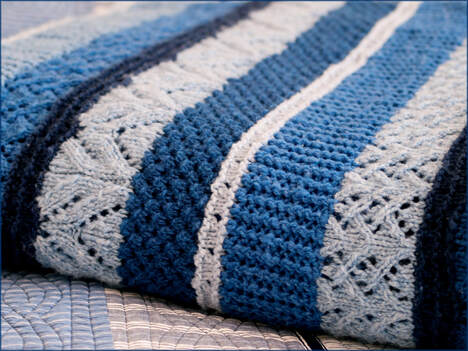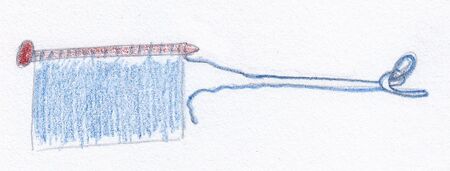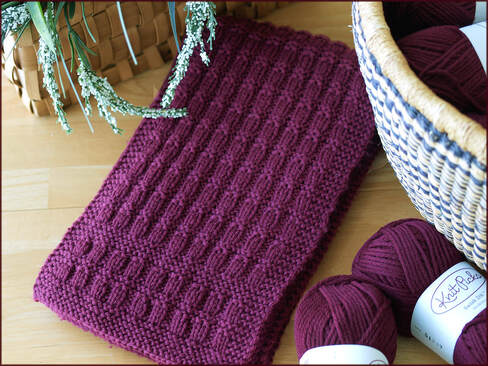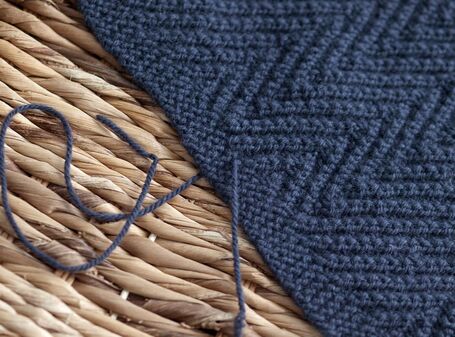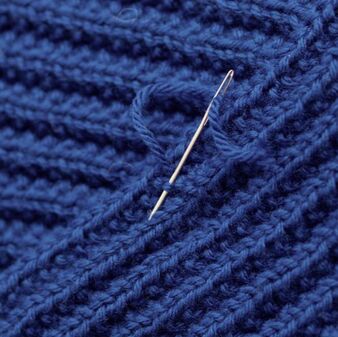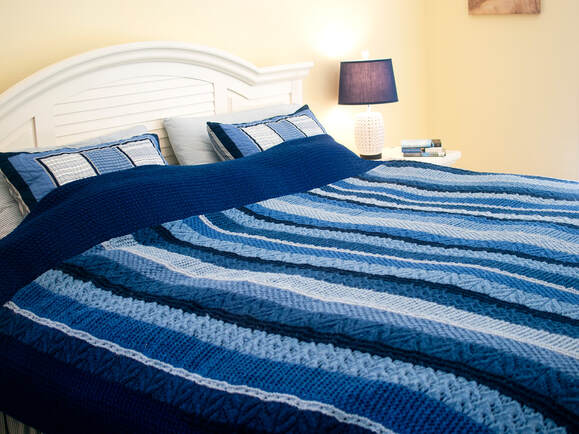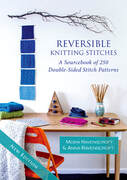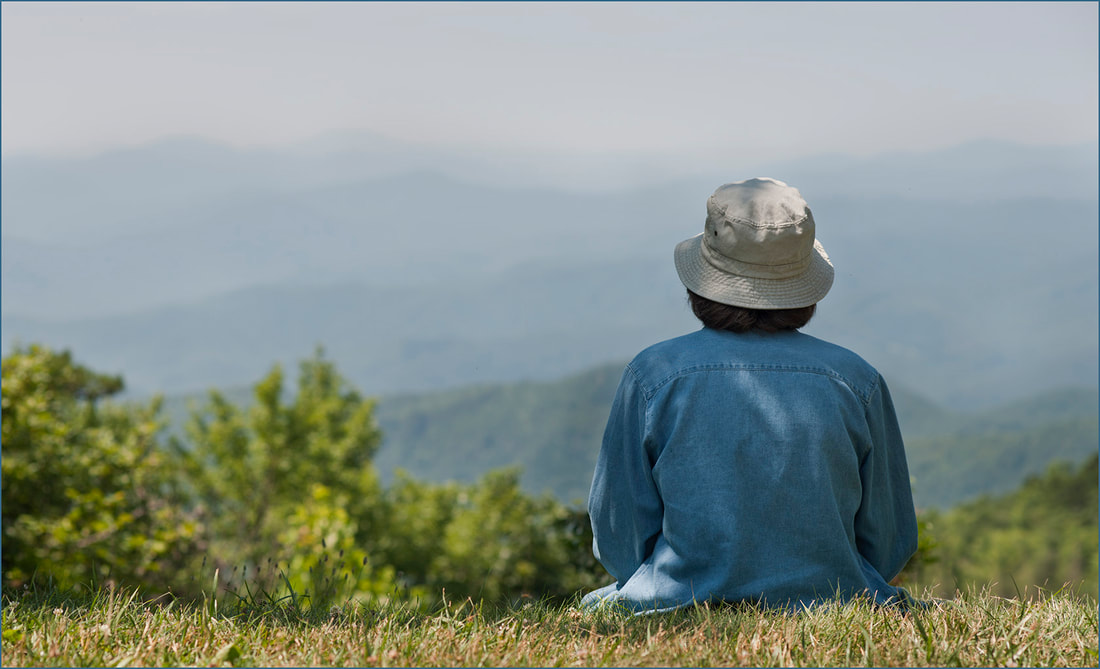Almost speaking together, we both said "Usually at the end of a row...", which when you come to think about it is not especially helpful.
So when is it usual to make the join at the end of a row? When is it not?
She proceeded to pull out a baby blanket she had been working on and showed us the large holes that had developed all the way through it. She looked close to tears. She had been told by someone to "just drop and take", ie to work to the end of your yarn, drop it, join in a new ball and continue on.
And that was what she had done, quite literally. She had worked right to the very last cm and then neatly pulled the next end to line up with it so as not to waste a single scrap of yarn. Of course, as the blanket came out of the knitting bag and went away again these ends had gradually unravelled to give the sorry-looking item we saw before us.
Margaret and I sat and honed our Kitchener stitch skills, bringing in extra lengths of yarn to reattach everything and finishing all the ends off, and by the end of the evening there was quite a reasonable baby blanket and a happy knitter.
I was thinking about this the other day while finishing off the Sawston Infinity Scarf, and thought it might make a good blogpost as a bit of a "Finishing Primer." So here are four scenarios for where to join in your yarn ends.
When I am working a piece of flat knitting, then I will almost always add a new ball of yarn at the end of a row. The yarn tails can then be worked into the spare material at the seam after the work is completed, and sometimes can even be used to help with the joining together of the pieces.
Then there are some stitch patterns such as Stocking Stitch/Stockinette St which can be really spoilt if there is a join in the middle of the row. It is hard to disguise the bulk of any yarn ends behind Stocking Stitch no matter how neatly they are worked in, so I always want these to be at the side where they will be less noticeable.
The same goes for Garter Stitch, as the joins can often disrupt the regular surface of the patterning. So I will position these joins at the side as well, as in the Derwent Cove Cushions above.
Colour work usually requires yarns to be brought in at the sides, except for specific techniques such as Intarsia. If there are many colour changes in a small area then I might choose to stagger these a bit, if possible, but usually it is best if these are right at the end.
For circular knitting, a new ball can be joined in at the end of a round or at the half-way point, which equates to the other side "seam".
Now knit to the other side or to the next position where a join could work. Did you get to the knot and have to undo it already?
If so, there is insufficient yarn to work another row and you should join in a new ball. If not, then undo the previous knot, fold the yarn end in half again and put a new loose knot into position to repeat.
I don't like having joins at the very edges of scarves, shawls, afghans and throws. So I will always position these at the inner edge of a border, or somewhere inconspicuous about 2-3cm/1 inch in from the Selvedge/Selvage.
In the Elizabeth Scarf above, this is where the Garter Stitch border meets the central pattern.
This means that I have the two yarn tails at opposite sides of the work and can give them a gentle tug to hold that join snugly without having to knot the ends together. Then later I use a tapestry needle to take the new yarn tail through the work to the back and finish it off. (BTW, this is a teaser look at the new Lamberhurst Scarf pattern coming soon!)
There are some patterns that really lend themselves to using every last piece of yarn. Cables are one of those. I will work to the centre of a cable crossing point knowing that I can later bury the yarn end deep into the textural folds on the WS of the cable design.
Ribbing is another case in point, as it is really easy to lose a yarn end down in the depths of the purl stitches in the rib, as in the Sawston Infinity Scarf pictured here.
Some lace designs work well this way too. Just make the transition between the old and new yarns at a point where there is enough space to weave the yarn tails into the back of the work. This often gives a better result than having multiple yarn ends being finished at the same location down the side, especially since the front edges are such a real feature of a lace shawl.
This type of joining is especially useful for reversible designs where both sides are the "Right Side".
However, there are many knitting projects where it really doesn't matter where you join in your new yarn. Rugs and blankets with strongly textured patterns would be good examples of this since the yarn ends will be safely hidden away on the wrong side. I often take liberties with yarn tails if the rows are very long too, as it would use up too much yarn to wait until you got to the other side.
Spinners will often meld a new ball of yarn with the old by splicing the ends together and gently working the twist across the join so that it holds securely. That way you can join in a new ball almost anywhere. This is especially useful for all-wool yarns, but I wouldn't normally advocate that for slippery yarns or machine-washable fibres which have been coated or treated to resist felting.
For these yarns I would suggest using a tapestry needle to work the yarn tails in opposite directions, either working at a bit of an angle or "Swiss Darning" the yarn end into the back of the stitch so that it is as neat as possible. I like to double back and just work the final end in the opposite direction to make sure everything is really secure, possibly even drawing the yarn through a strand to hold that end firmly in place.
Hopefully, if you carefully plan these ahead of time, then you will always have wonderful inconspicuous joins - and no holes in your next project.
I'll be back next time for the final blogpost of the year with news of that new men's scarf I talked about earlier.
Happy Knitting!
Moira
| Previous Blogpost: To Infinity and Beyond... Next Up: The Lamberhurst Scarf Our book: Reversible Knitting Stitches My Website: www.wyndlestrawdesigns.com |
finishing techniques, joining in yarn, joins, sewing in ends, end of a ball, do I have enough yarn, zR-231114

